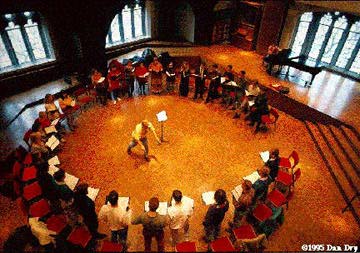 The University of Chicago Magazine
Feb 1995
The University of Chicago Magazine
Feb 1995
Return to February 1995 Table of Contents
Into the Music
Photography
by Dan Dry

Motet Choir rehearsals, conducted at noon in the Gothic splendor of Goodspeed Recital Hall, begin with warm-up exercises that stretch limbs as well as vocal chords.
Encircled by the 33 members of the Motet Choir, Director Bruce Tammen, AM'74, keeps his eyes on the score, his mind on the sound. As he finger-snaps the beat, he's keenly alert to subtleties of rhythm, intonation, and diction.
"Basses, I'd like you to lighten your sound just a little bit."
In blue jeans and flannel shirt, Tammen blends in with the singers who gather at noon on Mondays, Wednesdays, and Fridays in Goodspeed Recital Hall for 80-minute rehearsals of their demanding a cappella repertoire. There's not a music-performance major among them-indeed, the U of C has no formal performance training program. Yet competititon is heated among the College and graduate students who annually audition for places in the Motet, which enjoys a reputation as the University's top choral ensemble.
"See if you can add a little more diminuendo in the last bar."
Tammen is a Motet veteran. As a grad student, he sang baritone with the choir, founded in 1960 by the late Howard Mayer Brown to explore repertoire reflecting his scholarly passion for early music. In 1984, the director's baton was passed to Tammen, who also has degrees from Luther and Northwestern. Since then, the choir's focus has shifted a bit. "We still sing `art' repertoire rather than glees and old college songs," he says, "and we still focus at least half of our energies on pre-18th-century music." But the "new" Motet is more student- and performance-centered, giving regular concerts on campus, in the city, and-during its annual spring-break tour hosted by alumni groups-across the country. A busy two weeks in December found the choir singing two performances of the Messiah, caroling on the steps of Ida Noyes, and providing musical interludes at the Fall Quarter Convocation in Rockefeller Chapel. The fees for such performances help underwrite the spring tour. To come up with the remaining funds, members hawk T-shirts and hold occasional bake sales.
"Keep it going, don't get to the end too soon-it's just like reeling in a fishing line, tenors. Reeling…in…a…fishing…line."
While encouraging camaraderie among the crew, Tammen runs a tight ship. Students call in when they're sick and slip quietly into their places when late-running classes means a tardy arrival at Goodspeed. The sole break-midway through rehearsal-lasts no more than five minutes. Still, Tammen understands there are other must-show events in students' lives: When interviews for Rhodes scholarships conflict with a Messiah run-through, the interviews take precedence.
"You're singing really well-relative to everything else that's going on-but I really must have a bit more energy."
Despite all of Motet's demands, the drop-out rate is almost nil. What keeps the students going? Their answers sound a common chord. They like to sing with people who sing well, and, above all, they love the music.
"Don't ever let it turn into a technical exercise. It has to mean something."-M.R.Y.

True to its roots as an early-music workshop, the choir
regularly sings works by composers such as Purcell and Palestrina.
This past December the Motet combined forces with the Chapel Choir and
the Symphony of the Shores (left), to give two performances of
Handel's Messiah at Rockefeller. Click here for full
image.


Soprano Abby Brown (left) follows the lead of director Bruce Tammen. "The beauty of the piece," Tammen reminds his singers in rehearsal, "is in the competence with which you perform it." Click here for full images.
Go to feature, "The Unbearable Llightness of Being Bibfeldt"
Go to feature, "The Houses that Gautreaux Built"
Go to feature, "Upstaging Authority"
Go to CLASS NEWS
Return to February 1995 Table of Contents

 The University of Chicago Magazine
Feb 1995
The University of Chicago Magazine
Feb 1995

